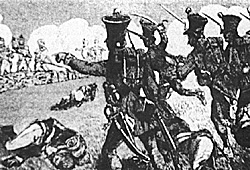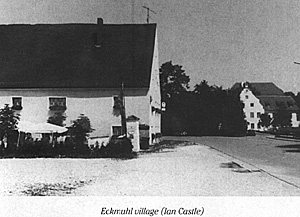 The year 1809 brought renewed hostilities between Austria and France and once again large numbers of troops were required from the Grenz. Including the 'final levies' of all males able to pick up a musket, over 100,000 Grenzers took part in all theatres of the 1809 war.
The year 1809 brought renewed hostilities between Austria and France and once again large numbers of troops were required from the Grenz. Including the 'final levies' of all males able to pick up a musket, over 100,000 Grenzers took part in all theatres of the 1809 war.
The Siebenburgen battalions and cavalry all went to Poland, while the 7 Warasdin, Slavonian and Banat Regiments sent their field battalions to Germany. In Italy, the Banal and 2 northern Karlstadt,(Ogulin and Szluin),regiments fought the French under Eugene. Austria was also threatened by Marmont's seasoned 'Army of Dalmatia', 14,300 strong with 78 guns, but could only muster about 8,000 men and 18 guns from the two field battalions of the Licca. regiment together with the poorly-trained and -equipped reserve battalions of the 4 Karlstadt Regiments and a few regular cavalry under GM (Major-General) Stoikevich. He pleaded for reinforcements and was sent 3 composite Land battalions, made up from the Karlstadt and Warasdin LandesDefensions; Divisions - these were more of a burden to Stoikevich, as they consisted mainly of untrained old men and youths. Two-thirds of them lacked serviceable muskets, nearly all had no proper uniforms or equipment and marched barefoot. Much more useful was the raising of a 1,400-strong Dalmatian Frei-Korps in early April 1809.(36)
Although bad weather delayed operations, Stoikevich was able to advance south out of the mountainous Licca area to the important defensive line of the Zermanja river in late April to pre-empt Marmont. Marmont gathered his forces and over 28th-30th April tried to break the Zermanja line - fierce resistance by the Licca field battalions at the vital Kravibrod stone bridge in particular thwarted the French Marshal, who withdrew south to Krun and Zara.
Prevented from moving further by the heavy snow of late April and the almost total failure of the supply lines, the Austrians were able to mount raids along the coast and against French depots Marmont commented in his memoirs "that from the mountains of Croatia, these bands descended, passed through the French encampments and laid waste the land between Kerka and the Zermanja" (37). When the advance got going, Stoikevich learned the true strength of the French in the area. Worse still, the French efforts to stir up the Bosnians and Turks around Trabnik (38) paid off - irregular hordes, as large as 5,000 strong crossed the border into the Karlstadt District, especially around Cetin, looting and burning the almost undefended Grenz settlements as far as Gospic and Ottocac.
Almost immediately on 9th May, Stoikevich ordered a general retreat on the Zermanja, just as Marmont was completing the concentration of his forces for an advance, following news of French success in Germany and Italy. Stoikevich was joined by two Banal reserve battalions, but could do little to stop the mayhem to the north - the available 2,500 defenders were overwhelmed as the Bosnian hordes left a trail of destruction and death across south-western Croatia. Tales of extreme violence and cruelty caused Stoikevich's forces to begin to melt away to defend their own settlements, as Marmont attacked the Austrian line. Stoikevich was decisively outmanoeuvred and defeated on 16th May at Mt. Kitta at the head of the Zermanja valley, north of Krun. The commander himself was captured and the Austrians were forced to retreat on Gospic, losing many prisoners en route. Total collapse of the Karlstadt District defences was only averted by Marmont being summoned to Vienna following Napoleon's defeat at Aspern on 21st/22nd May. FML Knesevich took over command and was able to rally the Grenzer, even advancing down the coast to lay siege briefly to Zara at the end of July, in co-operation with an AustroBritish flotilla. But by then, the Austrians had made peace after the main army's defeat, at Wagram, (5th/6th July).

In the main theatres of the 1809 war, the Grenzer had fought well, often in the 'light' role or as advanceguards. Defending the rear of Archduke John's army retreating from Italy, it was Grenzers under Artillery Captain Hensel, who mounted the heroic defence of the Malgaboreth and Predil blockhouses, Austria's Thermopalye. Tschaikisten took part in Captain Magdeburg's efforts to destroy the French bridge over the Danube at Aspern and, during the same battle, the Warasdin-St. Georger and Banal Grenzer were in their element trying to fight their way through the Gerneindeau thickets between Aspern village and the river. Perhaps the most poignant example of the warlike skills of the Grenzer was the defence of Eckmuhl village (at right), Bavaria by the two mainly-Serb Peterwardeiner battalions on 22nd April against the Wurttemberg Light Brigade with supporting horse artillery.
The first battalion repulsed two assaults on the river bridge, but after determined resistance had to give way. In hand-to-hand fighting, the two forces moved through the village towards the fortified manorhouse, where the second battalion was posted and fierce fighting continued.. Marshal Lannes described the village as "stuffed with infantry who held on to it like ringworm" and the aftermath was described thus,"Now, in that place, many men, also horses, wrecked wagons, cannons, muskets, cartridge boxes, boots with ripped-off feet in them, hands, arms and heads lay everywhere, many corpses lay in the houses and the manor-house, for the Austrian sharpshooters had certainly brought death to very many; but many of their men also lay among the dead"(39).
The Grenz 1809 - 1815
Defeated and exhausted, Austria signed the Peace of Schonbrunn in October 1809 and ceded the Karlstadt and Banal Districts, together with Civil Croatia west of the Drave river to the French. Their Grenz regiments, nos. 1-4 and 10/11 went into Napoleon's service and the area was joined to French Dalmatia and Istria to form the new 'Kingdom of Illyria'. The Austrian authorities were able to remove all remaining equipment and the Warasdin District became the base for a skeleton staff, ready to receive the ceded land and troops back. Informal contacts with the lost areas were maintained to encourage a steady flow of Grenzer refugees and deserters.
French policy was largely to ignore the area, although Marmont found himself being on the receiving end of the Bosnian marauders he had originally encouraged! Economic conditions did not improve and troops were still required to go to Russia in 1812,(two battalions), and Germany in 1813,(one battalion), albeit the French command kept their equipment to a minimum the remainder stayed in Illyria. Two battalions of Warasdin Grenzer were also part of the Austrian Auxiliary Corps under Schwarzenberg in Russia in 1812, where they suffered heavy casualties.
The French invasion also induced Tsar Alexander to make peace with the Turks in May 1812 and abandon the Balkans. Left with a free hand, the Turks crushed the Serbian forces by August 1813, causing a flood of over 100,000 refugees into the Slavonia and Banat Districts, (from this group a short-lived Serbian Frei-Korps was raised). Karageorges himself fled in October to Austria and was promptly imprisoned by the authorities.
Napoleon's 1812 disaster encouraged many more Grenzer to desert, a flow which increased when Napoleon disbanded all foreign units in November 1813 and it seems that almost all Grenzer had returned to their homesteads by May 1814, (40). Austrian policy was initially very cautious -Chancellor Metternich refused to back proposals to ferment rebellion in occupied lands. Peace was offered for the return of Illyria - despite having evacuated all trained troops from the area, Napoleon refused. Austria recommenced hostilities in August 1813.
With no threats from her eastern and southern flanks, Austria could raise the full strength of the remaining Grenz, aside from the two depleted Warasdin battalions. FML Hiller commanded the Austrian army in the Tyrol and Styria and from there, three brigades under FML Radivojevich were tasked to recover Croatia and Dalmatia. 5 Slavonian and Siebenburgen battalions formed part of Hiller's troops, while Radivojevich's 10,000 troops, gathered around Agram, comprised 3 Line and 3 Grenz battalions,(the two available Warasdin and one Slavonian), plus 4 squadrons of regular Hussars and some artillery(41). Vienna expected this small force to be joined quickly by Grenzer returning to their old allegiance, so the Hofkriegsrat prepared about 10,000 muskets in Kormend and supplied lists of reliable officers for re-appointment. They were not disappointed - Radivojevich crossed the Save on 17th August and marched on Karlstadt to popular acclaim. The French commander, Jeanin, saw his force evaporate before his eyes and fled.(42)
GM Nugent took over the operation with 2,000 men - and the returning Grenzer - as the main force turned west against Eugene. By mid-September, all of Croatia had been recovered, despite some resistance in coastal forts from a handful of Grenzer still loyal to France. Again, the bulk of the force was assigned to the main army in Italy, leaving FML Tomassic with a provisional Grenzer division to clear Dalmatia, a task he had essentially completed by the year's end.
In the very south of Dalmatia, Montenegrins, aided by the British had stirred up popular resistance and cleared much of the area by October 1813, although the big prizes, Ragusa and Cattaro still eluded them. As the Austrians approached, Ragusa fell to the British on 28th October, who then passed control to the Austrians. The rivalry between Austria and Montenegro for control of the two ports spilled over into open fighting between mainly Karlstadt District Grenzer and Montenegrin forces, so that Cattaro was able to hold out until February 1814. Only with Russian pressure on Montenegro could Austria finally secure the area by the summer of 1814. The local population, now very used to their rulers changing every few years, did little to aid liberation.
Thus peace finally returned to the Grenz in 1814, but yet more crop failures in 1814 and 1815 meant that economic conditions did not improve quickly. Grenzers were taken back from French service at their current rank, even if acquired from the French, although wearing French decorations was forbidden. Punitive measures were only taken against a few, who had openly aided the occupying power. Refugees from the occupied lands nearly all returned to their old properties, although some had to be resettled. Fortunately, pressure from Serb refugees was largely relieved by their returning to Serbia or being found land in southern Hungary.
Losses had been terrible - 1 in 9 never returned from service and nearly every Zadruga had lost a member. The population continued to rise slowly to 400,000 in the Croatian General Command and similarly elsewhere(43), but Imperial policy was now to halt further mass immigration from the Balkans.
Uniforms and Equipment, and Post-1815 Liquidation
More Jugoslavia
Back to Napoleonic Notes and Queries #13 Table of Contents
Back to Age of Napoleon List of Issues
Back to MagWeb Master List of Magazines
© Copyright 1993 by Partizan Press.
This article appears in MagWeb (Magazine Web) on the Internet World Wide Web.
Other military history articles and gaming articles are available at http://www.magweb.com